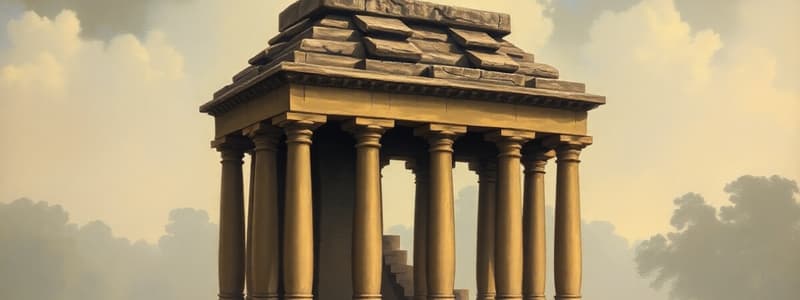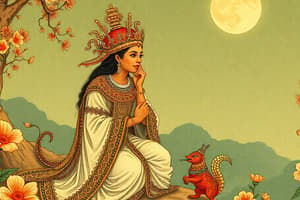Podcast
Questions and Answers
Which architectural feature, commissioned during the Satavahana period, enhanced the Sanchi stupa?
Which architectural feature, commissioned during the Satavahana period, enhanced the Sanchi stupa?
- A large, central Buddha statue
- Elaborate dome carvings depicting scenes from the Ramayana
- Gilded statues of Mauryan emperors
- Stone gateways or _toranas_ (correct)
What is the significance of the Shalbanjika figure in Buddhist art during the Sunga period?
What is the significance of the Shalbanjika figure in Buddhist art during the Sunga period?
- It depicts a scene of royal court life.
- It illustrates a Jataka tale.
- It represents Buddha's first sermon.
- It symbolizes the birth of Buddha, often showing a woman holding a tree. (correct)
Who was the founder of the Sunga dynasty?
Who was the founder of the Sunga dynasty?
- Vasudeva Kanva
- Pushyamitra Sunga (correct)
- Devabhuti
- Agnimitra
What was the social impact of the land grants made by the Satavahanas?
What was the social impact of the land grants made by the Satavahanas?
Which language gained prominence for official use during the Satavahana dynasty?
Which language gained prominence for official use during the Satavahana dynasty?
What economic activity was the Satavahana kingdom particularly well-known for?
What economic activity was the Satavahana kingdom particularly well-known for?
What is the primary subject matter of the Jataka tales depicted on the railings of the Barhut stupa?
What is the primary subject matter of the Jataka tales depicted on the railings of the Barhut stupa?
Which group posed the greatest competitive threat to the early Satavahana kingdom?
Which group posed the greatest competitive threat to the early Satavahana kingdom?
The Hathigumpha inscription is associated with which ruler and dynasty?
The Hathigumpha inscription is associated with which ruler and dynasty?
What does the title 'Dakshinapatha pati' signify in the context of the Satavahana rulers?
What does the title 'Dakshinapatha pati' signify in the context of the Satavahana rulers?
What marked Gautami Putra Satakarni's reign as distinct from other rulers of the Satavahana dynasty?
What marked Gautami Putra Satakarni's reign as distinct from other rulers of the Satavahana dynasty?
Why is Nagarjuna Konda significant in the history of Buddhism during the Satavahana period?
Why is Nagarjuna Konda significant in the history of Buddhism during the Satavahana period?
What role did Vasudeva Kanva play in the decline of the Sunga dynasty?
What role did Vasudeva Kanva play in the decline of the Sunga dynasty?
What is a key characteristic of the Chaitya architecture developed during the Satavahana period?
What is a key characteristic of the Chaitya architecture developed during the Satavahana period?
What was the primary function of a 'Vihara' during the Mauryan and Satavahana periods?
What was the primary function of a 'Vihara' during the Mauryan and Satavahana periods?
What does the presence of ship images on the coins of Yajna Sri Satakarni indicate about the Satavahana kingdom?
What does the presence of ship images on the coins of Yajna Sri Satakarni indicate about the Satavahana kingdom?
What is the significance of the term 'Gandhikas' in the social context of the Satavahana period?
What is the significance of the term 'Gandhikas' in the social context of the Satavahana period?
How did Rudra Daman I, the Saka ruler, interact with the Satavahana kingdom?
How did Rudra Daman I, the Saka ruler, interact with the Satavahana kingdom?
What administrative division was known as 'Ahara' during the Satavahana period?
What administrative division was known as 'Ahara' during the Satavahana period?
Which literary work is attributed to Gunadhya?
Which literary work is attributed to Gunadhya?
Flashcards
Pushyamitra Sunga
Pushyamitra Sunga
Founder of the Sunga dynasty.
Toranas
Toranas
Stone gates or gateways, added to Sanchi stupa during the Satavahana period.
Shalbanjika
Shalbanjika
Buddhist art depicting a woman or yakshi often holding a tree.
Agnimitra
Agnimitra
Signup and view all the flashcards
Gautami putra satakarni
Gautami putra satakarni
Signup and view all the flashcards
Satavahana Ruler
Satavahana Ruler
Signup and view all the flashcards
Yajna Sri Satakarni
Yajna Sri Satakarni
Signup and view all the flashcards
Rulers' Portraits on Coins
Rulers' Portraits on Coins
Signup and view all the flashcards
Land Grants to Brahman
Land Grants to Brahman
Signup and view all the flashcards
Gandhikas
Gandhikas
Signup and view all the flashcards
Prakrit
Prakrit
Signup and view all the flashcards
Jain namokar mantra
Jain namokar mantra
Signup and view all the flashcards
Study Notes
Sunga Dynasty
- Pushyamitra Sunga was a Brahmin Army chief of Brihadratha.
- Pataliputra was the Sunga dynasty capital.
- Menander and Demetrius led attacks against the Sunga dynasty.
- Stupas at Sanchi and Barhut were renovated during this period.
Barhut
- Ashoka constructed Barhut.
- Barhut features railings with Jataka tales and images of Yaksha and Yagni.
Sanchi
- Sanchi includes stone gates or toranas made by Satavahanas.
- Vesantara Jataka stories are depicted at Sanchi.
- Buddha is never depicted in human form at Sanchi.
Shalbanjika
- Buddhist art features images of women or Yakshi, often holding a tree or referencing Maya near a Sala tree giving birth to Buddha.
- Buddhist sites on stupas include stylized female figures by a tree, typically grasping or breaking a branch, symbolizing Buddha's mother, Maya.
- This art is related to ancient tree deities and fertility.
Literature
- Patanjali, was patronized and wrote the Mahabhasya.
Agnimitra
- Agnimitra is the hero of Kalidasa's poem, Malavikagnimitraim.
- He was Pushyamitra's son.
Last Ruler
- Devabhuti was the last ruler and was killed by his minister, Vasudev Kanva.
Chedi Dynasty
- The Chedi dynasty existed around 1st BCE.
- The Hathigumpha inscription was engraved by King Kharavela.
- Kharavela followed Jainism.
- Kharavela was also known as Cheta or Mahameghavahana.
- Kharavela defeated So Sata Kani.
Satavahanas
- Simukha founded the Satavahana dynasty.
- They were important successors to the Mauryas in the Deccan and central India.
- They are considered identical to the Andhras, mentioned in Matsya and Vayu Purana.
- The early Satavahanas were in Maharastra, later extending to Karnataka and Andhra.
- The Sakas were the greatest competitors to the Satavahanas.
Title
- The Satavahana rulers held the title Dakshinapata Pati.
Gautami Putra Satakarni
- Gautami Putra Satakarni was known as the only Brahman.
Vasisthaputra Pulumayi
- Vasisthaputra Pulumayi's capital was Paithan/Pratisthan, near Aurangabad.
Rudra Daman I
- Rudra Daman I, a Shaka ruler of Saurashtra, defeated the Satavahana twice but did not destroy them due to matrimonial alliances.
Yajna Sri Satakarni
- Yajna Sri Satakarni was a lover of trade and navigation.
- Images of ships are found on his coins.
Art and Architecture
- The Satavahanas were the first native Indian kings to issue their own coins, which included portraits of the rulers, a practice started by Gautami Pura Satakarni.
Material Culture
- Their material culture fused local elements with northern ingredients.
- Ancient goldwork was found in the Kolar fields.
- They issued coins of lead, and also potin/bronze/copper coins.
- They were famous for cotton cultivation.
Social Organization
- Satavahanas were the first rulers to make land grants to Brahmans.
- Gandhikas were perfumers who later became known as shopkeepers, bearing the modern title Gandhi.
- They followed a Matrilineal system but the throne was passed to a male member, indicating a Patriarchal aspect.
Administration
- The district was called Ahara.
- Amatyas and Mahamatras were officials.
- Senapati was a provincial governor.
- Gaulmika was the head of rural administration.
- Kataka and Skandhavaras were military camps and settlements.
Society
- Buddhist monks and Brahmans lived in small independent islands.
- Three grades of feudatories existed: King (Raja) had the right to strike coins, Mahabhoja, and Senapati.
Religion
- Brahmans worshipped a large number of Vaishnava gods.
- Buddhism, especially Mahayana, flourished.
- Nagarjuna Konda and Amaravati were important seats of Buddhist culture.
Architecture
- Rock-cut architecture was prominent.
- Chaitya refers to temples as large halls with columns, such as Karle Chaitya.
- Vihara refers to monasteries, residences for monks in the rainy season, built in the Mauryan period, such as Ellora caves.
Script and Language
- Prakrit was the official language.
- Brahmi script was used.
- Gathasaptasati is attributed to Hala.
- Gunadhya composed Brihatkatha.
Udayagiri and Khandagiri Caves
- Kalinga king Kharavela resided here.
- These caves were residences of Jain works.
- Udayagiri caves feature the Hathigumpha inscription.
- The Jain Namokar Mantra is associated with King Kharavela's military campaigns.
- Ranigumpha cave is a double-storied structure located in Udayagiri.
Studying That Suits You
Use AI to generate personalized quizzes and flashcards to suit your learning preferences.




